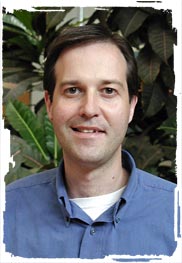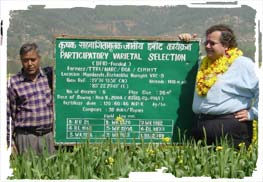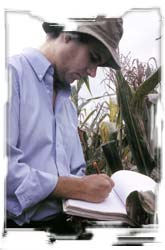Long as a man’s forearm, the biggest maize ears in the world are found in Jala, in the state of Nayarit, on the Pacific coast of Mexico. The traditional variety of this community is at risk, but a maize festival and the variety’s value in local culture and dishes keep farmers growing it, while researchers work to restore and improve its potential.
At the annual competition for the longest maize ear in the world, beauty queens and dignitaries wait in obscurity at the back of the stage, while the spotlight is on the bundles of ears lined up at the front. As darkness falls over the main square of the Mexican village of Jala on the evening of August 14, 2007, the 30 participating farmers are called onto the stage one by one, carrying their precious ears of maize. Each ear is systematically stripped of its husks and measured, and the data are recorded under the watchful eye of its grower. Many reach more than 30 cm (12 inches), and the first place goes to an ear 36 cm long.
At the height of the rainy season, lush, green fields and mountains surround Jala. The valley is overlooked by the active volcano Ceboruco, which last erupted in the 1870s and whose mineral-rich ash is believed by locals to make the giant Jala maize grow so well—indeed, it does not reach its full size when grown outside the valley. The variety is intimately adapted to its environment and an integral part of the identity and traditions of the people who grow it. Despite this, like many traditional varieties throughout Mexico, the Jala maize and the genetic diversity it carries are under threat of extinction, as improved varieties take over and young people leave the land looking for a better life. The competition for the biggest ear was established in 1981 in an attempt to ensure the preservation of Jala maize by encouraging farmers to grow it. It is held every year as part of the village’s two-week Feria del Elote, or green maize ear festival.
The Jala maize is a landrace—a traditional variety specific to a particular place that has been grown by farmers over generations. A number of other, regular-sized, landraces originating from other parts of Mexico are also grown in Jala. Collectively they are known as maíz de húmedo, as they have long growing seasons of around seven to eight months and are planted in April to take advantage of residual soil moisture before the summer rains begin.
Key ingredient in rich traditions and dishes
Jala maize grains contain a lot of flour. They are therefore prized for making boiled or roasted green ears, the Mexican flat-bread tortilla, pozole (a kind of pork and maize stew), gorditas (a sweet breadcake), and many other traditional dishes. But their flouriness also means the kernels are less dense and thus fetch a lower price on external markets, where maize is sold by weight.
Improved varieties of maize are inexorably supplanting the Jala landrace. They are shorter, which makes them easier to manage and less prone to falling over (lodging) in high winds, and yield much more (around 7-8 tons of grain per hectare, compared to around 3 tons per hectare for maíz de húmedo). Even more importantly, the improved varieties grown in Jala give relatively high yields of husks, which are exported to the USA and the rest of Mexico for wrapping tamales, a popular Mexican dish. The valley’s climate is changing, and the reduced rainfall also favors improved varieties, which reach maturity in around four to five months and thus can be sown in drier soils, after the rains begin. As a result less than 5% of the Jala’s maize-growing area is currently sown to the landrace. Furthermore, maize itself is being replaced by cash crops, predominantly blue agave for tequila and tobacco.
Recovering lost length
Because it has outcrossed with improved varieties, Jala maize’s prodigious height, ear length, ear thickness, and growing season have all diminished over the last century. In 1907 a visiting scientist recorded ears 60 cm long, whereas the longest in recent times have measured a mere 45 cm. Working to reverse these trends is J. Arahón Hernández Guzmán, research professor at the Colegio de Postgraduados, a Mexican agricultural institution. Hernández is growing landrace seed from 22 farmers in a plot in the valley to recombine the genetic variation. The seed will be redistributed to interested farmers, safeguarded in CIMMYT’s germplasm bank, and re-sown next year to begin selection for longer ears. He is also growing out Jala landrace samples from CIMMYT’s bank for selection and combination with current landrace materials. In addition to recovery and conservation, Hernández aims to develop varieties with added value; for example, dual-purpose maize providing good grain and husk yields, as well as specialized varieties for green ears or pozole. “This is important for me because, as a genetic resource, it’s unique in the world,” he says. “Not only that: if we lose this maize we lose our traditions, culture, and identity.”
Suketoshi Taba, Head of CIMMYT’s Maize Germplasm Collection, agrees the landrace is a unique expression of Jala’s culture, and will have value as long as people there choose to grow it. “CIMMYT holds Jala maize seed in trust, not just as a genetic resource for the world, but also for the people of Jala,” he says. “It’s important for us to preserve it on a permanent basis ex situ in the CIMMYT germplasm bank, and this complements its conservation in the field.” The Center holds 22,600 unique collections of Mexican and other maize landraces, and has provided seed and technical support to numerous researchers and farmers interested in their conservation and use.
Many reasons to grow Jala maize
But even if Jala maize can be restored and improved, will farmers continue growing it? Looking to stem the massive yearly flow of migrants out of the valley, local officials are tending to support the use of other, more profitable varieties and crops. “Maize is economically not very important,” says Jala mayor, Juan José Jacobo Solis.
Jala farmers talk of why they grow the landrace with a mixture of pride and pragmatism. They take pride in growing the biggest maize in the world, but also in their long tradition of caring for the seed. Pragmatically, they grow Jala maize for its high quality, because they enjoy eating it and because it can fetch high prices locally. The competition offers both—prizes and prestige.
Farmers will continue to grow more profitable and reliable improved varieties to sell the husks and grain. However, particularly with improved seed and supportive policies, it is likely that farmers will also continue to grow small plots of Jala maize for their own consumption and local sale, and for the competition. Their different purposes are complementary. Ultimately, the conservation of Jala maize in farmers’ fields is in the hands of farmers, and depends on the value they place on it.
As such, Jala is relevant to the conservation of other maize landraces: where people take pride in their local maize and value it for local needs such as traditional foods, it will be preserved. “I will always grow it,” says farmer José Elias Partida, “and now my son grows it too, and participates in the competition.”
 Now that all of CIMMYT’s new program directors have been officially installed, it is time to get acquainted with them, as well as their ideas and plans for the programs. This month we feature Jonathan Crouch, director of the Genetic Resources Program.
Now that all of CIMMYT’s new program directors have been officially installed, it is time to get acquainted with them, as well as their ideas and plans for the programs. This month we feature Jonathan Crouch, director of the Genetic Resources Program. Now that all of CIMMYT’s new program directors have been officially installed, it is time to get acquainted with them, as well as their ideas and plans for the programs. This month we feature Marianne Bänziger, director of the African Livelihoods Program.
Now that all of CIMMYT’s new program directors have been officially installed, it is time to get acquainted with them, as well as their ideas and plans for the programs. This month we feature Marianne Bänziger, director of the African Livelihoods Program. Now that all of CIMMYT’s new program directors have been officially installed, it is time to get acquainted with them, as well as their ideas and plans for the programs. This month we feature Kevin Pixley, director of the Tropical Ecosystems Program.
Now that all of CIMMYT’s new program directors have been officially installed, it is time to get acquainted with them, as well as their ideas and plans for the programs. This month we feature Kevin Pixley, director of the Tropical Ecosystems Program.